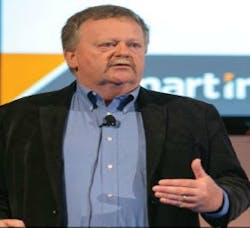An IoT tennis racket has gyroscopes, accelerometers and a piezoelectric sensor in the handle. These sensors pick up a variety of data, including where the ball hits the strings, how much power goes into a shot and how much spin a player puts on a ball, “all designed to help you improve your game,” Burke said. “With all this at our fingertips, the question becomes, ‘Why do you have to write custom code to use IoT in your industrial facility?’”
A global transformation
In the industrial world, Burke sees Industrie 4.0, China 20205, and the Industrial Internet Consortium (IIC) fostering the growth of a global digital transformation. But, “there are a lot of barriers in the architecture of the Industrial IoT,” Burke said. “To overcome these, we need to build complete solutions, not just add connectivity.”
Speaking from the perspective of the organization he leads, the OPC Foundation, Burke said, “In our vision, as an open-platform, plug-and-play information exchange standard for industrial applications, OPC UA builds on cloud protocols such as MQTT to integrate operations technology [OT] with IT,” referencing the RAMI 4.0 architectural model for Industrie 4.0.
The OPC Foundation has offices around the world, and about half the members are in Europe. “We have more than 4,200 companies with more than 35,000 products in more than 47 million installations,” Burke said. “And we want to see more in North America.”
Fundamental capabilities
The origin of “OPC” is arcane: “Just remember ‘UA’ stands for unifi ed architecture, C is for collaboration, and it brings a whole slew of products and architectures together,” Burke said. “We’re done with brand loyalty, with single-vendor solutions. We want to buy from multiple
vendors and have it all work together.” To effectively connect a multitude of industrial systems, platforms, applications and devices, OPC UA provides three essential capabilities:
1. Open data connectivity: “Like a printer driver— platform- and hardware-independent,” Burke said.
2. Data context preservation: “Like organizing photos by subject, location, etc. by storing metadata for who, what, when,” Burke said. “You can do the same for model of valve, location and application.”
3. Data security: “It’s scary to put data in the cloud,” Burke said. “OPC builds in security in accordance with standards from around the world.” These are the latest security standards accepted by IT and OT groups. OPC UA security is recognized by NIST, Industrie 4.0, MDIS and others as meeting the requirements of industrial systems.
“OPC started with client/server, now it’s also publish/subscribe. It started at the enterprise, now it’s embedded in devices,” Burke said. “We have OPC UA at the chip level, to embed into instruments. We’re seeing widespread adoption by system, platform, application and instrument manufacturers in the U.S., Germany and Japan. They can all spell OPC UA very well.”




